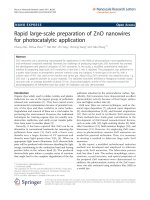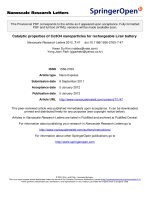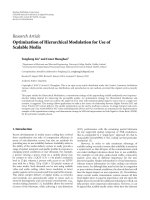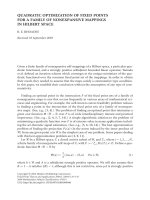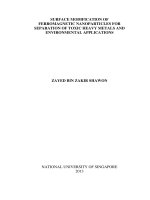Optimization of multifunctional nanoparticles for biosensor application
Bạn đang xem bản rút gọn của tài liệu. Xem và tải ngay bản đầy đủ của tài liệu tại đây (3.07 MB, 79 trang )
VIETNAM NATIONAL UNIVERSITY, HANOI
VIETNAM JAPAN UNIVERSITY
LO TUAN SON
OPTIMIZATION OF MULTIFUNCTIONAL
NANOPARTICLES FOR BIOSENSOR
APPLICATION
MASTER'S THESIS
…………………………….
MASTER OF NANOTECHNOLOGY
Hanoi, 2019
VIETNAM NATIONAL UNIVERSITY, HANOI
VIETNAM JAPAN UNIVERSITY
LO TUAN SON
OPTIMIZATION OF MULTIFUNCTIONAL
NANOPARTICLES FOR BIOSENSOR
APPLICATION
MAJOR: Nanotechnology
CODE: Pilot
RESEARCH SUPERVISOR:
Associate Prof. Dr. NGUYEN HOANG NAM
Hanoi, 2019
ACKNOWLEDGEMENT
At first, I would like to express my acknowledgement to my supervisor,
Associate Prof. Dr. Nguyen Hoang Nam, for his advice, instructions, for
supplying researching environment in laboratory and for giving motivation
during my research.
I would like to express my gratefulness to Professor. Tamiya, my supervisor
in Osaka during this internship for supplying working environment, all of group
meeting, seminars, discussion and suggestion for my research and my future
plans.
I sincerely thank all professors, staff, and friends in Vietnam Japan University
and VNU - University of Science for supplying me the best condition for my
research.
Hanoi, 10th, June, 2019
TABLE OF CONTENT
LIST OF FIGURES
LIST OF TABLES
LIST OF ABBREVIATION
CHAPTER 1: GENERAL INTRODUCTION...................................................... 1
1.1. Targeted nanoparticles and biosensors for disease therapy in biomedicine1
1.2. Multi - functional magnetite-silica-amine-gold nanoparticles (MSAANPs)
3
1.2.1. Magnetite nanoparticles (MNPs).................................................... 3
1.2.1.1. Introduction............................................................................ 3
1.2.1.2. Magnetic property.................................................................. 4
1.2.1.3. Synthesis of magnetite nanoparticles..................................... 5
a. Co-precipitation method........................................................... 5
b. Thermal decomposition of iron organic precursor method.......6
1.2.2. Core-shell structure magnetite-silica nanoparticles........................7
1.1.2.1. Roles of silica shell................................................................ 7
1.1.2.2. Coating silica shell on magnetite nanoparticles.................... 7
a. Stöber method........................................................................... 7
b. Inverse microemulsion............................................................ 10
1.2.3. Multifunctional magnetite-silica nanoparticles.............................11
1.2.3.1. Introduction.......................................................................... 11
1.1.3.2. Application of multifunctional magnetite - silica
nanoparticles........................................................................................................... 12
a. Drug delivery system.............................................................. 12
b. Hyperthermia.......................................................................... 13
c. MRI imaging........................................................................... 14
1.3. Multi - functional MSAANPs applied for biosensor.............................. 14
1.4. Investigation and optimization of experimental procedure....................16
1.4.1. Synthesis of MNPs......................................................................... 16
1.4.2. Synthesis of MSNPs....................................................................... 17
CHAPTER 2: PRINCIPLES OF MEASUREMENT METHODS......................19
2.1. Dynamic Light Scattering (DLS) measurement..................................... 19
2.2. Zeta Potential measurement................................................................... 20
2.3. Transmission Electron Microscope (TEM) measurement......................21
2.4. Ultraviolet - visible spectroscopy (UV-VIS).......................................... 22
2.5. X-ray Diffraction (XRD)........................................................................ 23
2.6. Vibrating sample Magnetometer (VSM)................................................ 23
2.7. Fourier Transform - Infrared Spectroscopy (FT-IR)............................... 24
CHAPTER 3: EXPERIMENTAL PROCEDURE............................................... 26
3.1. Synthesis and characterization of MNPs, MSNPs, MSANPs and
MSAANPs............................................................................................................................... 26
3.1.1. Magnetite nanoparticles (MNPs).................................................. 26
3.1.2. Magnetite/silica nanoparticles (MSNPs)...................................... 26
3.1.3. Synthesis of magnetite-silica nanoparticles functionalized by amine
groups (MSANPs).......................................................................................................... 27
3.1.4. Magnetite/silica/amine/gold nanoparticles (MSAANPs)...............28
3.2. Investigation and optimization of synthesis procedure...........................28
3.2.1. Investigation of effect of pH on PSD and zeta potential of MNPs . 28
3.2.2. Investigation of effect of surfactant on stability of MNPs.............29
3.2.3. Investigation of effect of temperature on silica coating reaction...29
3.2.4. Investigation of effect of TEOS on magnetic properties of MNPs in
silica coating reaction................................................................................................. 30
3.2.5. Investigation of mechanism of silica coating reaction.................. 30
CHAPTER 4: RESULTS AND DISCUSSION................................................... 31
4.1. Characterization of MNPs, MSNPs, MSANPs and MSAANPs.............31
4.1.1. TEM and DLS results.................................................................... 31
4.1.2. UV-VIS results............................................................................... 33
4.1.3. FT-IR results................................................................................. 34
4.1.4. VSM results................................................................................... 37
4.1.5. XRD results................................................................................... 39
4.2. Investigation and optimization of experimental procedure....................42
4.2.1. Effect of pH on stability of MNPs.................................................. 42
4.2.2. Effect of surfactant on preventing aggregation of MNPs during
silica coating reaction................................................................................................. 45
4.2.3. Effect of temperature on silica coating reaction............................ 47
4.2.4. Effect of silica precursor on the magnetic properties of magnetite
core...................................................................................................................................... 48
4.2.5. Effect of silica precursor on the mechanism of silica coating
reaction.............................................................................................................................. 51
CONCLUSION................................................................................................... 55
FUTURE PLAN................................................................................................. 56
REFERENCES................................................................................................... 57
LIST OF FIGURES
Figure 1.1. Some application of nanoparticles as targeted agent in medical
diagnosis............................................................................................................................ 1
Figure 1.2. Working principles of biosensor using combined CCD camera
and fluorescence............................................................................................................. 2
Figure 1.3. Working principle of biosensor measuring the change in electrical
impedance......................................................................................................................... 3
Figure 1.4. Crystal structure of magnetite....................................................... 4
Figure 1.5. Vibrating sample Magnetometer (VSM) spectrum of MNPs
proves their superparamagnetic property.............................................................. 4
Figure 1.6. Chemical formula of tetraethyl orthosilicate.................................7
Figure 1.7. Possible processes in silica coating reaction.................................8
Figure 1.8. Competitive reactions between silica growing on silica
nanoparticles and silica seeds................................................................................. 10
Figure 1.9. Synthesis of MNPs by inverse microemulsion method...............11
Figure 1.10. Some branch of functionalizing silica layer on magnetite - silica
nanoparticles................................................................................................................. 12
Figure 1.11. Principle of hyperthermia method using MNPs........................13
Figure 1.12. MRI images of human brain without using (left) and using (right)
MNPs............................................................................................................................... 14
Figure 1.13. Structure of magnetite - silica - amine - gold nanoparticles......15
Figure 1.14. Procedure of synthesizing MSAANPs......................................15
Figure 1.15. Criteria of MSAANPs needed to be optimized in this research.18
Figure 2.1. Working principles of DLS measurement...................................19
Figure 2.2. Description of zeta potential....................................................... 20
Figure 2.3. Instrumental components of TEM.............................................. 21
Figure 2.4. Instrumental components of UV-VIS measurement....................23
Figure 2.5. Working components of VSM measurement..............................24
Figure 3.1. Chemical formula of PVP........................................................... 26
Figure 3.2. Chemical formula of APTES...................................................... 28
Figure 4.1 (left). TEM image of magnetite nanoparticles.............................31
Figure 4.2 (right). Particles size distribution of magnetite nanoparticles
calculated from TEM measurement..................................................................... 31
Figure 4.3. TEM image of magnetite-silica nanoparticles.............................31
Figure 4.4. TEM image of MNAANPs......................................................... 32
Figure 4.5. Particles size distribution (PSD) of MNPs, MSNPs, MSANPs and
MSAANPs..................................................................................................................... 33
Figure 4.6. UV-VIS spectra of MNPs, MSNPs (sample MS5) and MSAANPs34
Figure 4.7. FT-IR spectra of MNPs, MSNPs and MSANPs..........................35
Figure 4.8. VSM spectra of MNPs and MSNPs (sample MS4).....................37
Figure 4.9. VSM spectra of samples MNPs, MS6 and MSAANPs (1000/H
versus Ms)...................................................................................................................... 38
Figure 4.10. XRD spectra of MNPs and MSAANPs.................................... 39
Figure 4.11. PSD and zeta potential of MNPs under different pH................42
Figure 4.12. Sedimentation of MNPs under different pH.............................. 43
Figure 4.13. Effect of sodium citrate on sedimentation of MNPs.................44
Figure 4.14. Description of PVP playing a role on the stabilization of MNPs45
Figure 4.15. PSD and zeta - potential of MNPs under different concentration
of PVP............................................................................................................................. 46
Figure 4.16. Sedimentation experiment of MNPs under different
concentration of PVP................................................................................................. 47
Figure 4.17. TEM images of (a): sample MS5 and (b): sample MS5.1.........47
Figure 4.18. DLS results of (a): sample MS5 and (b): sample MS5.1...........48
Figure 4.19. VSM results of sample MNPs, MS1, MS2, MS3, MS4 and MS549
Figure 4.20. Hydrodynamic diameter of MNPs during silica coating reaction51
Figure 4.21. The change (Δd) of hydrodynamic diameter of sample MNPs,
MS4, MS5, MS6, MS7 during silica coating reaction.................................. 52
Figure 4.22. DLS spectra of sample MS4, MS5. MS6 and MS7 after 24h
during silica coating reaction.................................................................................. 53
LIST OF TABLES
Table 3.1. Reacting condition from sample MS1 to MS7.............................27
Table 4.1. Positions and corresponding type of vibration of MNPs, MSNPs
and MSANPs................................................................................................................. 36
Table 4.2. Magnetic parameters of samples MNP, MS6 and MSAANPs
calculated from their VSM spectra................................................................ 39
Table 4.3. Position of diffraction peaks of magnetite in sample MNPs and
their crystal parameters............................................................................................. 41
Table 4.4. Position of diffraction peaks of gold nanoparticles in sample
MSAANPs and their crystal parameters.............................................................. 41
Table 4.5. Comparison between some magnetic parameters of sample MNPs,
MS1, MS2, MS3, MS4 and MS5.......................................................................... 50
Table 4.6. Efficiency of silica coating of sample MS4, MS5 and MS7........54
CHAPTER 1: GENERAL INTRODUCTION
1.1. Targeted nanoparticles and biosensors for disease therapy in
biomedicine
The current development of Nanotechnology is promising for application in
biomedicine. Nanoparticles are kind of material that owns many specical
properties such as high surface area, great biocompatibility and potential abilities
to be modified [26]. Research about nanoparticles, as shown in figure 1.1,
applied in medicine are currently focusing on disease through imaging, detection
and therapeutics with various products being approved in clinical [12].
Figure 1.1. Some application of nanoparticles as targeted agent in medical
diagnosis
There are several approach to design biosensors for disease diagnosis.
Biosensor that using flow cytometry technique shows its advantage in the rate
and accuracy of counting disease cells [59]. However, this device is usually
expensive and not be able to be applied in hospitals that have limited budget. For
that reason, many research groups are interested in minimizing and simplizing
equipment to reduce costs and improve its portability. Microcontroller chips were
designed and developed by groups such as Massachusetts General Hospital,
Harvard Medical School to measure and image size, proportion and uniformity of
targeted cells using digital camera technology (CCD camera) and self -
1
developed algorithm to count the number of targeted cells in a chamber
microflora [45]. However, the image sensor and bio-chips in this technique is just
one time - used [35].
Figure 1.2. Working principles of biosensor using combined CCD camera
and fluorescence
Fluorescent technology have been developed and combined with CCD
camera in order to increase the accuracy of measurement and simultaneous
detection of targeted cells, as illustrated in figure 1.2. The principle of this
method is similar to the biosensors that just use single CCD camera, except that
the system uses two color LEDs and a color image sensor to identify
fluorescently marked cells. However, the type of device is still quite bulky and its
accuracy depends on the specificity of antibodies against used in the device [20].
To overcome this drawback, another method that can be applied is the
counting cells system by measuring electrical impedance [53]. As shown in
figure 1.3, targeted cells will be captured by antibodies that are functionalized on
the electrode surface, that leads to the change of electrode impedance. The
variable impedance was measured to estimate the number of targeted cells in the
specimen. Although this method own high precision in measuring impedance, the
accuracy of calculated number of targeted cells still depends on the ability to
capture targeted cells on the surface of electrode.
2
Figure 1.3. Working principle of biosensor measuring the change in electrical
impedance
Developing targeted nanoparticles is a currently promising branch for the
disease diagnosis using biosensor. Some measurement can be applied for
detecting disease such as measuring concentration of cancer cell or
simultaneously observing them in human body [23]. Magnetic nanoparticles is
very appropriate for applying in targeted diagnosis. Since it owns very high ratio
of surface area to volume and ease to be functionlized, nanoparticles can be
modified by attaching with functional groups such as amine, carboxylic acid to
connect with biological molecules [25]. Moreover, some metal nanoparticles such
as gold, silver or zinc also can be attached for detection by photo luminescence or
localized surface plasmon resonance (LSPR).
1.2.
Multi - functional magnetite-silica-amine-gold nanoparticles
(MSAANPs)
1.2.1. Magnetite nanoparticles (MNPs)
1.2.1.1. Introduction
Magnetite (iron (II,III) oxide or ferrous-ferric oxide) is one kind of iron oxide
that show ferrimagnetic property [24,58]. The empirical formula of magnetite,
which is Fe3O4, is usually considered as a combination of one ferrous oxide and
one ferric oxide. Magnetite shows inverse spinel lattice structure, as illustrated in
figure 1.4. Each unit cell consists of 32 O 2- anions occupying and forming face centered cubic (FCC) lattice. 8 trivalent iron (Fe III) and 8 divalent iron (Fe II)
atoms occupy in 16 octahedral sites and the rest 8 trivalent iron (Fe III) atoms
occupy in 8 tetrahedral sites [40]. Magnetite undergoes Verwey transition from
3
monoclinic to cubic structure when temperature decreases to a certain point.
Research have found out that this transition of magnetite occurs at 120 K [19]
Figure 1.4. Crystal structure of
magnetite 1.2.1.2. Magnetic property
The Curie temperature of magnetite is 850K. Below this temperature,
magnetite show ferrimagnetic properties due to alignment of magnetic moments
in its crystal structure. The tetrahedral sites, where are occupied by Fe 3+ cations
express ferromagnetic moments, whereas it is anti-ferromagnetic in octahedral
sites occupied by both Fe2+ and Fe3+ cations. Therefore, they cancel each other
and lead to the ferrimagnetic property of magnetite [16]
Figure 1.5. Vibrating sample Magnetometer (VSM) spectrum of MNPs
proves their superparamagnetic property
4
When the diameter of MNPs reduces to below 30 nm, the number of
exchange - coupling spins that resist magnetic reorientation decrease. That leads
to the appearance of superparamagnetic property of MNPs [17]. This
superparamagnetic property of MNPs can be verified by the absence of hysteresis
loop in its magnetization spectrum, also the value of coercivity and saturation
remanence (can be determined by taking intercept of VSM spectrum to the Ox
and Oy axes respectively) are approximately zero, as shown in figure 1.5.
Superparamagnetic property of MNPs plays important role in controlling its
magnetic behaviour. MNPs can be easily become magnetically saturated at low
magnetic field and after its removal, there is almost no magnetic remanence. That
makes MNPs can be used in application that requires separating process for
micro and nano - subjects.
1.2.1.3. Synthesis of magnetite
nanoparticles a. Co-precipitation method
One of the most popular method to synthesize MNPs is co-precipitation
method, which is discovered 30 years ago by Massart [26]. This reaction bases on
the co-precipitation of Fe2+ and Fe3+ in basic aqueous solution.
Fe2+ + 2Fe3+ 8OH- → Fe3O4 + 4H2O
The mechanism of this reaction is complicated and not direct. Some
complexes of iron was formed as intermediates [33].
(Fe(H2O)6)3+ → FeOOH + 3H+ +4H2O
Fe2+ +2OH- → Fe(OH)2
2FeOOH + Fe(OH)2 → Fe3O4 + 2H2O
Co-precipitation method shows its advantage in requiring simple reacting
condition and equipment. In addition, this method is applicable for producing a
large amount of MNPs. However, adjustments should be applied to obtain MNPs
with narrow size distribution, suitable size of single nanoparticles and good
dispersion. In details, narrow size distribution of MNPs can be obtained if the
nucleation and growth process can be proceeded separately [47]. Hence, high
temperature should be required to obtain unique MNPs. The size distribution of
5
obtained single MNPs can be smaller and narrower when some salt is added to
reacting solution. For examples, addition of 1 M NaCl can minimizes the average
diameter of the nanoparticles for 1.5 nm [5].
Another drawback of co-precipitation method is that MNPs tend to aggregate
during reaction to form very big cluster that can not be called nanoparticles and
would not able to be applied in biomedicine. Their superparamagnetic property
make sure that they can not attach with each other by magnetic remanence,
however their crystal surface with large surface area/volume ratio lead to very
high surface energy and very sensitively and easily to be aggregated. To
overcome this problem, some surfactant, such as polyvinylpyrrolidone (PVP) are
used to cover the surface of MNPs and minimize surface energy. The strong
interaction between outer crystal planes of MNPs is replaced by weak Van Der
Waals interaction of PVP covered on their surface. They would not able to be
aggregated since this Van Der Waals interaction is much more weaker than their
Brownian motion in solution.
b. Thermal decomposition of iron organic precursor method
MNPs with high uniformity in size also can be synthesized through method
called thermal decomposition. This method uses organometallic precursors such
as hydroxylamineferron [Fe(Cup)3], iron pentacarbonyl [Fe(CO)5], ferric
acetylacetonate
[Fe(acac)3],
iron
oleate
[Fe(oleate)3]
[29].
In
thermal
decomposition method, these precursors are heated up to their boiling point in a
non - polar solvent and decomposed to form MNPs with controllable morphology
and narrow size distribution. Capping agent, such as fatty acids and
hexadecylamine is used in this method for size adjustment. Morphology of the
nanoparticles is affected by ratio of precursor/non-polar solvent and the heating
rate.
This method can produces MNPs with narrow size distribution [55] and also
various morphology that can be controlled by changing reaction parameters.
However, thermal decomposition cannot produce large amount of nanoparticles
6
as co-precipitation method. In addition, the environmental problem of this
method should be considered since most of used precursors are highly toxic [10].
1.2.2. Core-shell structure magnetite-silica nanoparticles
1.1.2.1. Roles of silica shell
MNPs still exist difficulties to be applicable in biomedicine. MNPs was
reported about their possibility to be oxidized and perform free radicals that have
toxic effect for human body [3]. In addition, MNPs synthesized using coprecipitation method are easy to be aggregated due to their high surface energy,
whereas MNPs via thermal decomposition method can be monodispersed but
hydrophobic and therefore not suitable for biomedicine application [38, 30, 52].
Moreover, it is difficult to attach the other crystal materials to MNPs to form
multifunctional nanoparticles due to their inconsistency in crystal parameters
[46].
Coating surface of MNPs by silica (SiO2) shell can overcomes all of these
problems. Silica was reported as non-toxic material [31], therefore coating silica
shell can reduces toxicity of magnetite core and improves their biocompatibility.
The aggregation of MNPs can be prevented by the amorphous structure of silica
that results in the decrease of surface energy of MNPs. Moreover, the amorphous
surface of silica shows high potential for functionalizing with organic groups
such as amine, cacboxyl or the other metal nanoparticles [44]
1.1.2.2. Coating silica shell on magnetite
nanoparticles a. Stöber method
Figure 1.6. Chemical formula of tetraethyl orthosilicate
7
Stöber method, which was discovered the first time by Werner Stöber in 1968
[51], is a kind of sol-gel process to synthesize silica or coated - silica
nanoparticles. In this method, silica is formed by the hydrolysis of silica containing precursor. The most common silica precursors was used is tetraethyl
orthosilicate (TEOS, figure 1.6). This reaction can takes place in both acidic and
basic medium. For synthesizing free silica nanoparticles, the size distribution by
this method is from 0.05 to 2 µm, while it depends on the initial size of
nanoparticles precursor when silica is coated. The possible process of silica
coating reaction can be summarized in figure 1.7.
Figure 1.7. Possible processes in silica coating reaction
The first step in silica coating reaction is the hydrolysis of TEOS. Using
labeling method [6], the mechanism of this reaction was found that the ethoxyl (OC2H5) groups in TEOS is replaced by hydroxyl (-OH) groups. This -OH group
comes from water molecules as reactant, or from the -OH groups on the surface
of MNPs.
Si(OOC2H5)4 +H2O → Si(OC2H5)3OH + C2H5OH
Si(OOC2H5)3OH + H2O
Si(OOC2H5)2(OH)2 + H2O
Si(OC2H5)(OH)3 + H2O
8
The hydrolysis of TEOS can be proceeded in both acidic or basic catalyst,
though the mechanism of hydrolysis step are quite different [11, 36]. The
intermediates after this hydrolysis step are Si(OC 2H5)3OH, Si(OC2H5)2(OH)2,
Si(OC2H5)(OH)3, and Si(OH)4. pH, the initial concentration of TEOS and water
and temperature are main factors that affect to the rate of hydrolysis reaction [11].
Increasing these factors (acidity or basicity, increase temperature or concentration
of precursors) will increase the rate of hydrolysis step.
Bases on many factors, the next process can be deposition of intermediates
on the surface of MNPs or nucleation and self-growing processes to perform free
silica nanoparticles [11]. Since the deposition is more thermodynamically stable
than the nucleation process, this second step prefers to the silica growing on the
surface of MNPs in low reaction rate. If some factors are changed to promote this
process, such as increasing temperature or concentration of TEOS, the nucleation
of silica seed would becomes dominant. That leads to a competitive reactions of
silica growing between on the surface of MNPs and surface of silica seeds [1], as
shown in figure 1.8. As a consequence, the formation of free silica nanoparticles
reduces the efficiency of silica coating reaction and also reduces the quality of
MSNPs.
9
Figure 1.8. Competitive reactions between silica growing on
silica nanoparticles and silica seeds
Stöber method is one of simplest way to synthesize silica-shell nanoparticles
since it requires simple reacting conditions and equipment. However, the
formation of silica layer is very complicated, that leads to side - reactions such as
aggregation of nanoparticles, broad size distribution, or formation of free silica
nanoparticles. Hence, the condition of silica coating reaction through Stöber
method need to be controlled and optimized to produce expected MSNPs
b. Inverse microemulsion
Microemulsion is a method for synthesizing MSNPs which have thick silica
layer and narrow size distribution. Since MNPs synthesized by co-precipitation
method are hydrophilic, the water - in - oil system, or inverse microemulsion is
used to coat silica layer on MNPs.
10
Figure 1.9. Synthesis of MNPs by inverse microemulsion method
Micro - water droplet (inverse micelles) is formed when the mixture of
aqueous phase and organic phase are mixed stably. The size of this droplet
depends mainly on the ratio of aqueous phase and organic phase and the mixing
condition, and that also affect to the size distribution of product. Changing
amount of magnetite or silica precursors also varies the morphology of MSNPs.
Increasing concentration of MNPs leads to the formation of multi-core MSNPs,
while increasing concentration of silica precursor (usually TEOS) tend to form
free silica nanoparticles which does not contain magnetite core [21].
Inverse microemulsion shows its advantage in performing single-core
magnetite-silica nanoparticles effectively, whereas the aggregation of magnetite
nanoparticles during silica coating reaction in Stöber method is more difficult to
be controlled [50]. However, coating silica in single MNPs would increases the
silica/magnetite ratio, therefore the magnetic property of magnetite-silica
nanoparticles would be significantly reduced. Moreover, this method has low
yield and requires complex conditions such as very high stirring speed and
centrifuging.
1.2.3. Multifunctional magnetite-silica nanoparticles
1.2.3.1. Introduction
11
Figure 1.10. Some branch of functionalizing silica layer on magnetite silica nanoparticles.
Figure 1.10 illustrates the diversity of silica shell in attaching with various
materials to become multifunctional nanoparticles. Since silica layer owns
amorphous structure and is ease to be modifiable, MSNPs is usually used to
attach with other agents, such as metal nanoparticles, drug, quantum dot and
enzyme. The product is called multifunctional nanoparticles because their
property is a combination between the magnetic properties of magnetite core and
property of attaching agent.
1.1.3.2. Application of multifunctional magnetite - silica
nanoparticles a. Drug delivery system
Drug delivery using nanomaterials as carrier is currently promising research
field. To be applied in this drug delivery system, this nanomaterials must satisfy 3
mains standards: to be highly biocompatible, selective transporting to disease
cells and effectively release drug. Some studies proved that the ideal
hydrodynamic diameter of nanoparticles for this application is less than 200 nm
[13]. The mechanisms of drug release are mainly based on diffusion, magnetic
field, temperature, pH, electric field dependent, ultrasonic sound and
electromagnetic radiation [61].
Multifunctional silica coated - magnetite nanoparticles are potential choice in
drug delivery system. The silica shell expresses high biocompatibility and its
12
amorphous structure can be functionalized to improve the efficiency of drug
delivery. One of the most promising development of this field is thermosensitive
PNIPAAm (poly (Nisopropylacrylamide)) drug loading/release system. Due to its
phase transition from hydrophylic to hydrophobic state at the critical solubility
temperature of 32˚-33˚C – this mechanism can be used as a carrying ligand for
hydrophylic drugs.
b. Hyperthermia
Hyperthermia is considered as a simple and reckless method for direct
treatment of disease cells. Principles of this method, as shown in figure 1.11,
bases on the convertible ability from magnetic to thermal energy of magnetite
core. First, magnetite - carried agent was attached to selective tumor cells. After
applying external magnetic field, MNPs absorb magnetic energy and convert it to
thermal energy. As a results, the temperature of tumor cells increases, and they
would be eliminated if their temperature excesses 43ºC [8]
Figure 1.11. Principle of hyperthermia method using MNPs
In this hyperthermia application, multifunctional MSNPs can be used as a
targeting agent. While magnetite core kills tumor tissues by overheating method,
silica shell plays a role as a stabilizer for magnetite core, protective material for
13
toxicity of magnetite and modifiable material for functionalization [49]. This
biomedical application needs magnetite - silica nanoparticles of the highest
quality and many clinical tests due to risks of harming normal cells, especially in
treatments of the brain tumors.
c. MRI imaging
One of a most powerful tool to visualize information of body internal
structure is magnetic resonance imaging (MRI). This method can observes soft
tissues, detect physiological and chemical changes in organism. The principles of
MRI bases on the change of spin momentum of protons in human body under a
strong external magnetic field. This instrument work well especially in human
body since water takes 70 percent of weight. MNPs can improves contrast of
MRI image, as shown in figure 1.12, due to their magnetic property. Since they
have their own magnetization, the relaxation time of proton in water can be
modified [47]. The criteria of contrast agent should be stability, safety,
biodistribution, tolerance [34], but efficiency and quality are poor so actual
researches in this field are promising the new generation of high efficiency
contrast agents.
Figure 1.12. MRI images of human brain without using (left) and using (right)
MNPs
1.3. Multi - functional MSAANPs applied for biosensor
14
Figure 1.13. Structure of magnetite - silica - amine - gold nanoparticles
Figure 1.13 illustrates the structure of magnetite-silica-gold nanoparticles,
which is the target for synthesizing, investigating and optimizing of this research.
This multifunctional nanoparticles follows the core - shell structure, which
contain MNPs as the core and coated by silica shell. This silica layer was
modified by attaching with some functional groups and metal nanoparticles. This
research focuses on attaching amine (-NH2) groups and gold (Au) nanoparticles.
Figure 1.14. Procedure of synthesizing MSAANPs
The synthesis of this nanoparticles was followed by procedure that is shown
in figure 1.14. MNPs was synthesized using co-precipitation method of ferrous
and ferric salt solutions with PVP as a stabilizer. The MNPs then was coated by
silica layer through Stöber method. This silica layer plays a role as an amorphous
surface to be easier in modifying than the crystal surface of MNPs. Moreover, the
15
